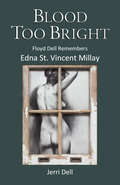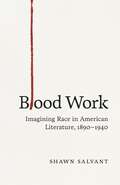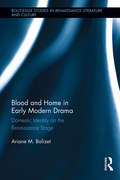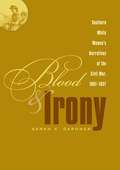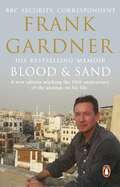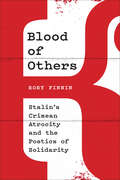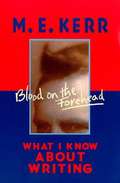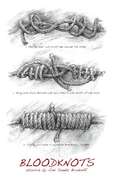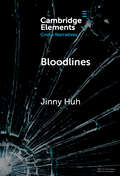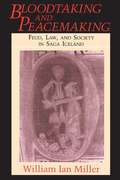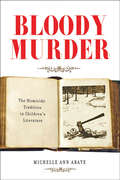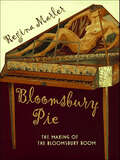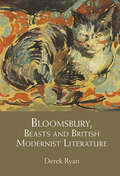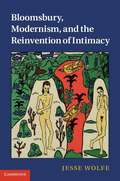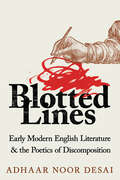- Table View
- List View
Blood Too Bright: Floyd Dell Remembers Edna St. Vincent Millay
by Floyd Dell Jerri DellWhat lips my lips have kissed, and where, and why,I have forgotten*One hundred years ago, Bohemian author and editor of the radical Masses magazine, Floyd Dell, began a passionate affair with a newcomer to Greenwich Village — the yet to be discovered “girl poet,” Edna St. Vincent Millay. In the years that followed, both Dell and Millay became symbols of early 20th century feminism, rebellion and literary freedom.A century later, while poring over her grandfather Floyd’s papers at Chicago’s Newberry Library, Jerri Dell discovered hundreds of handwritten letters and an unpublished memoir about his love affair with Millay. Finding him as outlandish, entertaining and insightful as he was when she knew him fifty years before, she chose to bring him and his poet lover back to life within the pages of this book.Admirers of Edna Millay — as well as literary and political history buffs, Bohemian Village enthusiasts, and readers interested in writers who famously influenced social norms — are sure to enjoy this eye-witness account of a fascinating woman and exceptional poet. My candle burns at both ends;It will not last the night* *Excerpts from Sonnet XLIII and First Fig by Edna St. Vincent Millay
Blood Work: Imagining Race in American Literature, 1890--1940
by Shawn SalvantThe invocation of blood-as both an image and a concept-has long been critical in the formation of American racism. In Blood Work, Shawn Salvant mines works from the American literary canon to explore the multitude of associations that race and blood held in the consciousness of late nineteenth- and early twentieth-century Americans. Drawing upon race and metaphor theory, Salvant provides readings of four classic novels featuring themes of racial identity: Mark Twain's Pudd'nhead Wilson (1894); Pauline Hopkins's Of One Blood (1902); Frances Harper's Iola Leroy (1892); and William Faulkner's Light in August (1932). His expansive analysis of blood imagery uncovers far more than the merely biological connotations that dominate many studies of blood rhetoric: the racial discourses of blood in these novels encompass the anthropological and the legal, the violent and the religious. Penetrating and insightful, Blood Work illuminates the broad-ranging power of the blood metaphor to script distinctly American plots-real and literary-of racial identity.
Blood and Home in Early Modern Drama: Domestic Identity on the Renaissance Stage (Routledge Studies in Renaissance Literature and Culture)
by Ariane M. BalizetIn this volume, the author argues that blood was, crucially, a means by which dramatists negotiated shifting contours of domesticity in 16th and 17th century England. Early modern English drama vividly addressed contemporary debates over an expanding idea of "the domestic," which encompassed the domus as well as sex, parenthood, household order, the relationship between home and state, and the connections between family honor and national identity. The author contends that the domestic ideology expressed by theatrical depictions of marriage and household order is one built on the simultaneous familiarity and violence inherent to blood. The theatrical relation between blood and home is far more intricate than the idealized language of the familial bloodline; the home was itself a bloody place, with domestic bloodstains signifying a range of experiences including religious worship, sex, murder, birth, healing, and holy justice. Focusing on four bleeding figures—the Bleeding Bride, Bleeding Husband, Bleeding Child, and Bleeding Patient—the author argues that the household blood of the early modern stage not only expressed the violence and conflict occasioned by domestic ideology, but also established the home as a site that alternately reified and challenged patriarchal authority.
Blood and Irony
by Sarah E. GardnerDuring the Civil War, its devastating aftermath, and the decades following, many southern white women turned to writing as a way to make sense of their experiences. Combining varied historical and literary sources, Sarah Gardner argues that women served as guardians of the collective memory of the war and helped define and reshape southern identity. Gardner considers such well-known authors as Caroline Gordon, Ellen Glasgow, and Margaret Mitchell and also recovers works by lesser-known writers such as Mary Ann Cruse, Mary Noailles Murfree, and Varina Davis. In fiction, biographies, private papers, educational texts, historical writings, and through the work of the United Daughters of the Confederacy, southern white women sought to tell and preserve what they considered to be the truth about the war. But this truth varied according to historical circumstance and the course of the conflict. Only in the aftermath of defeat did a more unified vision of the southern cause emerge. Yet Gardner reveals the existence of a strong community of Confederate women who were conscious of their shared effort to define a new and compelling vision of the southern war experience.In demonstrating the influence of this vision, Gardner highlights the role of the written word in defining a new cultural identity for the postbellum South.During the Civil War, its devastating aftermath, and the decades following, many southern white women turned to writing as a way to make sense of their experiences. Combining varied historical and literary sources, Sarah Gardner argues that women served as guardians of the collective memory of the war and helped define and reshape southern identity. She considers such well-known authors as Caroline Gordon, Ellen Glasgow, and Margaret Mitchell and also recovers works by lesser-known writers such as Mary Ann Cruse, Mary Noailles Murfree, and Varina Davis. Gardner reveals the existence of a strong community of Confederate women who were conscious of their shared effort to define a new and compelling vision of the southern war experience. In demonstrating the influence of this vision, Gardner highlights the role of the written word in defining a new cultural identity for the postbellum South.-->
Blood and Sand: The BBC security correspondent’s own extraordinary and inspiring story
by Frank GardnerOn the June 6, 2004, while on assignment in Riyadh, BBC security correspondent Frank Gardner and cameraman Simon Cumbers were ambushed by Islamist gunmen. Simon was killed outright. Frank was hit in the shoulder and leg. As he lay in the dust, a figure stood over him and pumped four more bullets into his body at point-blank range...Against all the odds, Frank Gardner survived. Today, although partly paralysed, Frank continues to travel the world, reporting and making documentaries for the BBC. This acclaimed memoir was brought up to date with a new chapter that recounted his return to Saudi Arabia for the first time since he was shot and the story he tells continues to move and inspire, and remains an affirmation of his deep understanding of - and affection for - the Islamic world in these uncertain times.___'Gardner tells his remarkable tale well and bravely, with an astonishing lack of anger and enduring love and respect for the Islamic world' SUNDAY TIMES'Brave, unsentimental and genuinely inspiring' EVENING STANDARD 'What makes Gardner's moving, often humorous, deeply personal story so important is the fact that he has woven into it a brilliantly dispassionate, clear-eyed account of the Islamic world' SCOTSMAN'A witty, self-deprecating, inspiring testament' DAILY TELEGRAPH
Blood of Others: Stalin's Crimean Atrocity and the Poetics of Solidarity
by Rory FinninIn the spring of 1944, Stalin deported the Crimean Tatars, a small Sunni Muslim nation, from their ancestral homeland on the Black Sea peninsula. The gravity of this event, which ultimately claimed the lives of tens of thousands of victims, was shrouded in secrecy after the Second World War. What broke the silence in Soviet Russia, Soviet Ukraine, and the Republic of Turkey were works of literature. These texts of poetry and prose – some passed hand-to-hand underground, others published to controversy – shocked the conscience of readers and sought to move them to action. Blood of Others presents these works as vivid evidence of literature’s power to lift our moral horizons. In bringing these remarkable texts to light and contextualizing them among Russian, Turkish, and Ukrainian representations of Crimea from 1783, Rory Finnin provides an innovative cultural history of the Black Sea region. He reveals how a "poetics of solidarity" promoted empathy and support for an oppressed people through complex provocations of guilt rather than shame. Forging new roads between Slavic studies and Middle Eastern studies, Blood of Others is a compelling and timely exploration of the ideas and identities coursing between Russia, Turkey, and Ukraine – three countries determining the fate of a volatile and geopolitically pivotal part of our world.
Blood on the Forehead: What I Know About Writing
by M. E. KerrUsing examples from five novels and five short stories, young adult writer M. E. Kerr offers insights into ways writers can get ideas and create successful stories.
Bloodknots
by Ami Sands Brodoff"Bloodknots is a truly singular and remarkable book of stories. Lyrical and disturbing, this is the work of a writer of unmistakable talent."--Joan Silber, author of Ideas of Heaven, a National Book Award nominee"Bloodknots is a marvelous collection peopled by unforgettable characters."--Nalini Warriar, author of Blues from the Malabar Coast and a McAuslan Book Award winnerA collection of beguiling stories from an American writer who excels at depicting the family ties that bind: fathers, mothers, sons, and daughters whose connections to one another are as fragile as they are irrevocable. Stubbornly honest, and imbued with a sensibility that speaks to the author's Jewish heritage, Ami Sands Brodoff writes with authority, passion, and razor-sharp detail about identity and the longing for human connections in the face of loss and exclusion. Her stories evoke the delicate familial weaves of Alice Munro, exposing the raw nerves of shattered lives redeemed by the willingness to forgive. Written close to the senses, Bloodknots penetrates to the core.Ami Sands Brodoff is from New York and also lived in Princeton, New Jersey, before relocating with her husband to Montreal, where she writes and teaches creative writing. Her work has received a Pushcart Prize nomination and has been anthologized in numerous journals and book collections. Her first book, Can You See Me?, received wide acclaim, including a rave from Publishers Weekly.
Bloodlines: Adoption, Crime, and the Search for Belonging (Elements in Crime Narratives)
by Jinny HuhThis study explores the relationship between crime fiction and adoption. A primary goal of this study is to investigate how the adoption trope reveals current cultural fears and fascination with kinship formations and essentialist notions of belonging, DNA and ancestry searches, and the controversial practice of adoption. Popular fiction, namely crime/detective fiction and the subgenre of adoption crime fiction, reflect scholarly debates within the field of Critical Adoption Studies, including but not limited to the ethics behind the adoption industrial complex and calls for its demise, struggles for reproductive justice, and redefinitions of parenting and kinship formations evidenced by LGBTQ and racialized identities. Another goal of this study is to highlight adoptee and birthparent voices and perspectives, illustrating how genre fiction can help to agitate for more inclusive representation. By intersecting elements of crime into the adoption story, these narratives illuminate the human cost and condition of current adoption practices.
Bloodtaking and Peacemaking: Feud, Law, and Society in Saga Iceland
by William Ian MillerDubbed by the New York Times as "one of the most sought-after legal academics in the county," William Ian Miller presents the arcane worlds of the Old Norse studies in a way sure to attract the interest of a wide range of readers. Bloodtaking and Peacemaking delves beneath the chaos and brutality of the Norse world to discover a complex interplay of ordering and disordering impulses. Miller's unique and engaging readings of ancient Iceland's sagas and extensive legal code reconstruct and illuminate the society that produced them. People in the saga world negotiated a maze of violent possibility, with strategies that frequently put life and limb in the balance. But there was a paradox in striking the balance—one could not get even without going one better. Miller shows how blood vengeance, law, and peacemaking were inextricably bound together in the feuding process. This book offers fascinating insights into the politics of a stateless society, its methods of social control, and the role that a uniquely sophisticated and self-conscious law played in the construction of Icelandic society. "Illuminating."—Rory McTurk, Times Literary Supplement "An impressive achievement in ethnohistory; it is an amalgam of historical research with legal and anthropological interpretation. What is more, and rarer, is that it is a pleasure to read due to the inclusion of narrative case material from the sagas themselves."—Dan Bauer, Journal of Interdisciplinary History
Bloody Murder: The Homicide Tradition in Children's Literature
by Michelle Ann Abate"Off with her head!" decreed the Queen of Hearts, one of a multitude of murderous villains populating the pages of children's literature explored in this volume.Given the long-standing belief that children ought to be shielded from disturbing life events, it is surprising to see how many stories for kids involve killing. Bloody Murder is the first full-length critical study of this pervasive theme of murder in children’s literature. Through rereadings of well-known works, such as Alice’s Adventures in Wonderland, the Nancy Drew Mystery Stories, and The Outsiders, Michelle Ann Abate explores how acts of homicide connect these works with an array of previously unforeseen literary, social, political, and cultural issues. Topics range from changes in the America criminal justice system, the rise of forensic science, and shifting attitudes about crime and punishment to changing cultural conceptions about the nature of evil and the different ways that murder has been popularly presented and socially interpreted. Bloody Murder adds to the body of inquiry into America's ongoing fascination with violent crime. Abate argues that when narratives for children are considered along with other representations of homicide in the United States, they not only provide a more accurate portrait of the range, depth, and variety of crime literature, they also alter existing ideas about the meaning of violence, the emotional appeal of fear, and the cultural construction of death and dying.
Bloomsbury Pie: The Making of the Bloomsbury Boom
by Regina MarlerCelebrated and maligned with equal vigor, the Bloomsbury Group is the best-documented artistic coterie in twentieth-century literature. The novelists Virgonia Woolf and E.M. Forster, the artists Roger Fry, Duncan Grant, and Vanessa Bell, and the economist John Maynard Keynes were among this charmed circle that emerged in London before the First World War and came to exercise a complex, lingering influence on English art and letters. Theirs was a world of great talent--even genius--sexual intrigue, and gossip; they cultivated an atmosphere in which it was possible to say anything, do anything. Their peak of influence in the 1920s was followed by forty years of sustained sidelong derogation, and occasional frontal attack, from such famously hostile critics as D.H. Larence and Wyndham Lewis, until, in the 1960s, the idea of Bloomsbury exploded in the public imagination, transforming the Group into an almost mass-market attraction.Not in their darkest nightmares could Bloomsbury's contemporary detractors have imagined that Charleston Farmhouse, where Vanessa Bell and Duncan Grant once lived and painted, would eventually attract some 15,000 visitors each year, or that a high-profile film, Carrington, would be based on Lytton Strachey's largely platonic love affair with an obscure artist on the fringes of the hallowed Group. Bloomsbury Pie examines the persistent allure of Bloomsbury--a fascination driven by nostalgia, adoration, and antipathy--and tracks the resurgence of interest in the Group, from a handful of biographies in the 1960s through the feminist discovery of Virginia Woolf in the 1970s and the enshrinement of the Bloomsberries as cultural icons in the 1980s and 1990s. Drawing on a wealth of material generated by this revival, Regina Marler chronicles the story of the Bloomsbury boom--its scholars, collectors, and fanatics and explores the industry it has spawned among writers, publishers, and art dealers. In the proces she creates an impressive social history of a tenacious and unwieldy cultural phenomenon.
Bloomsbury, Beasts and British Modernist Literature
by Derek RyanBloomsbury, Beasts and British Modernist Literature reveals how the Bloomsbury group's fascination with beasts – from pests to pets, tiny insects to big game – became an integral part of their critique of modernity and conceptualisation of more-than-human worlds. Through a series of close readings, it argues that for Leonard Woolf, David Garnett, Virginia Woolf and E. M. Forster, profound shifts in interspecies relations were intimately connected to questions of imperialism, race, gender, sexuality and technology. Whether in their hunting narratives, zoo fictions, canine biographies or (un)entomological aesthetics, these writers repeatedly test the boundaries between, and imagine transformations of, human and nonhuman by insisting that we attend to the material contexts in which they meet. In demonstrating this, the book enrichens our understanding of British modernism while intervening in debates on the cultural significance of animality from the turn of the twentieth century to the Second World War.
Bloomsbury, Modernism, and the Reinvention of Intimacy
by Jesse WolfeBloomsbury, Modernism, and the Reinvention of Intimacy integrates studies of six members and associates of the Bloomsbury group into a rich narrative of early twentieth century culture, encompassing changes in the demographics of private and public life, and Freudian and sexological assaults on middle-class proprieties Jesse Wolfe shows how numerous modernist writers felt torn between the inherited institutions of monogamy and marriage and emerging theories of sexuality which challenged Victorian notions of maleness and femaleness. For Wolfe, this ambivalence was a primary source of the Bloomsbury writers' aesthetic strength: Virginia Woolf, D. H. Lawrence, and others brought the paradoxes of modern intimacy to thrilling life on the page. By combining literary criticism with forays into philosophy, psychoanalysis, sociology, and the avant-garde art of Vienna, this book offers a fresh account of the reciprocal relations between culture and society in that key site for literary modernism known as Bloomsbury.
Blossoms English Reader (Semester 1 and 2) class 7 - Andhra Pradesh Board
by State Council of Educational Research and Training Andhra PradeshThis book has sem-1 four units and sem-2 four units. It is a vital resources for students in which all the units are thematically organized with passages meant for Listening, Reading and activities focus on reading comprehension, vocabulary, grammar, study skills. Measures have been taken to help learners get the rules familiarized with different generes such as narratives, essays, biographical sketch, plays, poems etc. which have been constructed in oral and written.
Blossoms English Reader class 1 - Andhra Pradesh Board
by State Council of Educational Research and Training Andhra PradeshThis book has total eight units. Children should focus on warm-up time, sharing time, action time, circle time, fun time, practice time & ryhmes. Responds orally to frame a sentences to the pictures given.
Blossoms English Reader class 2 - Andhra Pradesh Board
by State Council of Educational Research and Training Andhra PradeshThis book has 8 units. Each unit is divided into 2 parts. Children should focus on warm-up time, sharing time, action time, circle time,fun time,practice time. Frame a story to the given picture and answer the following questions.
Blossoms English Reader class 3 - Andhra Pradesh Board
by State Council of Educational Research and Training Andhra PradeshBlossoms English Reader for class 3, published by the Samagra Shiksha Government of Andhra Pradesh, is designed to enhance the English language skills of third-grade students through a blend of stories, poems, and interactive activities. It covers reading comprehension, vocabulary, grammar, writing, listening, and speaking skills. Key stories include "Tenali Rama and the Thieves," "The Recipe Book," and "The Loyal Mongoose," each accompanied by comprehension questions and grammar exercises. Themes such as honesty, teamwork, loyalty, and compassion are explored, promoting moral values. Additional features include the National Anthem and Pledge to instill patriotism. The book's structured approach ensures students not only learn language mechanics but also develop critical thinking and creative expression.
Blossoms English Reader class 4 - Andhra Pradesh Board
by State Council of Educational Research and Training Andhra PradeshThis book has total eight units. It is a vital resources for students in which all the units are thematically organized with passages meant for Listening, Reading and activities focus on reading comprehension, vocabulary, grammar. Measures have been taken to help learners get the rules familiarized with different generes such as narratives, essays, biographical sketch, plays, poems etc. which have been constructed in oral and written.
Blossoms English Reader class 4 - Andhra Pradesh Board
by State Council of Educational Research and Training Andhra PradeshA fourth-grade English reader from the Andhra Pradesh State Board, titled “Blossoms - 4.” It includes various units designed to enhance students' English language skills through stories, activities, and exercises. Each lesson is crafted to develop reading, writing, grammar, vocabulary, and listening abilities. The book covers a range of themes, including stories about famous personalities, moral tales, and imaginative narratives. It integrates interactive elements like pre-reading activities, comprehension questions, crossword puzzles, and grammar exercises to engage students and build their language proficiency in a structured and enjoyable manner.
Blossoms English Reader class 5 - Andhra Pradesh Board
by State Council of Educational Research and Training Andhra PradeshThe Class 5 English textbook, Blossoms - 5, designed by the Andhra Pradesh Board, aims to develop language skills through engaging stories, poems, grammar exercises, and interactive activities. The book contains lessons from diverse genres and themes, both Indian and international, fostering comprehension, vocabulary enrichment, and grammatical proficiency. Each unit encourages students to think critically, express creatively, and apply their knowledge through writing tasks, role-playing, and project work. The book also emphasizes moral values and life skills, such as empathy, courage, and teamwork, while nurturing a love for language through stories, poetry, and language games. The curriculum is structured to promote holistic development, focusing on listening, speaking, reading, and writing, preparing students for real-life communication.
Blossoms English Reader class 6 - Andhra Pradesh Board
by State Council of Educational Research and Training Andhra PradeshThis book has total eight units. It is a vital resources for students in which all the units are thematically organized with pre-reading,glossary, reading comprehension,vocabulary, grammar,writing, talking time, fun time and check points. Measures have been taken to help learners get the rules familiarized with different generes such as narratives, essays, biographical sketch, plays, poems etc. which have been constructed in oral and written.
Blossoms English Textbook class 7 - West Bengal Board
by West Bengal Board of Secondary EducationThe English textbook "Blossoms" for Class VII, published by the West Bengal Board of Secondary Education, aims to foster a love for the English language through a child-centric and activity-based approach. It aligns with the vision of the National Curriculum Framework 2005 and the Right to Education Act 2009. The book introduces students to a range of literature, blending classic and contemporary works that emphasize human relationships and real-world applications of language. Each chapter includes stories, poems, and engaging exercises designed to develop reading, writing, listening, and speaking skills. Supplementary activities such as storytelling, role-playing, and collaborative projects encourage creativity and participation, ensuring a holistic learning experience. The textbook also includes a teacher's guide for effective implementation in classrooms.
Blossoms class 6 - West Bengal Board
by West Bengal Board of Secondary EducationBlossoms is an English textbook designed for Class VI students under the West Bengal Board of Secondary Education. Based on the curriculum developed by an expert committee, it follows a child-centric, activity-based approach to learning in line with the National Curriculum Framework (NCF) 2005 and the Right to Education (RTE) Act 2009. The book introduces students to renowned literary works, fostering their language skills through engaging stories, poems, and exercises. Each lesson is structured with reading materials, discussions, and interactive activities to enhance comprehension, vocabulary, and creative expression. Themes include adventure, imagination, history, and moral values, ensuring holistic development. The book also integrates grammar and writing tasks, making language learning both enjoyable and effective.
Blotted Lines: Early Modern English Literature and the Poetics of Discomposition
by Adhaar Noor DesaiBlotted Lines rebuffs centuries of mythologization about the creative process—the idea that William Shakespeare "never blotted out line"—to argue that by studying how early modern writers faced the challenges of writing poetry, instructors today can empower their students' approaches to critical writing. Adhaar Noor Desai offers deeply researched accounts of how poetic labor intersected with early modern rhetorical theory, material culture, and social networks.Tracing the productive struggles of such writers as George Gascoigne, Philip Sidney, John Davies of Hereford, Lady Anne Southwell, and Shakespeare across their manuscripts, Desai identifies in their work instances of discomposition: frustration, hesitation, self-doubt, and insecurity. Inspired to unmake their poems so that they might remake them, these poets welcomed discomposition because it catalyzed ongoing thinking and learning. Blotted Lines brings literary scholarship into conversation with modern composition studies, challenging early modern literary studies to treat writing as both noun and verb and foregrounding the ways poetry and criticism alike can model for students the cultivation of patience, collaboration, and risk in their writing.
